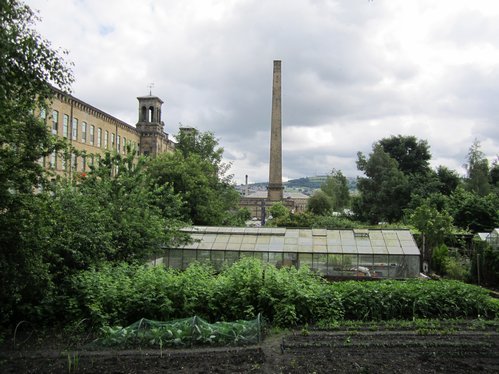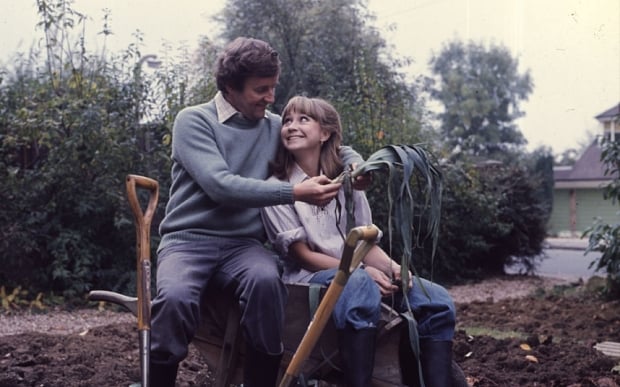The History of Allotments
The origin of the modern allotment is an interesting one, and seems to have had two very different beginnings running in parallel before what we now know as an allotment was created. On the one hand the enclosure of common land led to a provision of growing land for the rural poor, and on the other the move into towns driven by the industrial revolution led to ‘city allotments’ that were predominantly gardened by the well-off middle classes.
The Enclosures
The process of enclosure started as almost as early as the Norman Conquest. It was a process by which previously common land once held in an open field system was divided up and enclosed by new hedges, and the use of the land became restricted to the owner.
By 1750 there was an active movement for Parliamentary enclosure, and over the next 100 years entire parishes were enclosed at a time, and new hedges were planted to divide the fields, changing the landscape forever. Over this period the majority of common land in Britain was enclosed leaving a whole class of rural dispossessed.
Throughout this period of enclosure there were various movements to try and provide ground for the common labourer. As early as 1649 a group that called themselves the ‘Diggers Movement’ who were protesting for the ‘right to dig’ for all. A group of hungry men, led by Gerrard Winstanley, they organised a mass trespass on waste land in St George’s Hill, Surrey, sowing it with vegetables and wheat.
The ‘Diggers’ efforts were quickly dispersed by the government; however the idea of a ‘right to dig’ is still very much alive today.
The social unrest caused by the process of enclosure led to a number of private initiatives to provide the common man with land to grow and provide for himself. This was mainly driven by private land owners who commonly believed that not only would a small patch of land be worth more to their workers than an increase in salary, but that it also kept them busy and away from the ale house, and therefore better workers.
Because too large an area might lead to the workers being tired, it also led to a restriction on the size of allotments provided so that men would not exhaust themselves before turning up for their paid employment.
The General Enclosure Act in 1845 made the provision of “field gardens” for the poor and limited to a quarter of an acre compulsory. In reality however this made very little difference to the landless.
1884’s elections were fought mainly according to each party’s position on allotments, as the key issue of the day. The allotment party won and in 1887 the Allotments Act was introduced, which made it possible for local authorities to acquire land for allotments – by compulsory purchase if necessary. It also made it compulsory for local authorities to provide allotments where there was demand for them.
Local authorities resisted however, and this led to further Acts in 1894, and then finally the Smallholding and Allotments Act of 1907 which forced councils to provide allotments where there was demand. This is still in place today and a local authority is obliged to provide allotments if there is demand from more than 6 people (although this does not apply in central London for example where space is insufficient)

Urban Allotments and the Industrial Revolution
These have a very different beginning to the rural allotments. Demand for inner city allotments came originally not from the poor in an attempt to grow their own food, but rather from the relatively well off middle classes who wanted space to both grow their own, and more importantly to have a garden to relax and escape the confines of the city.
These were driven by the 19th century obsession with gardening, and also as a show of wealth by those who would tenant them. These became known as ‘pleasure gardens’ and would often feature brick built summerhouses and small folly’s that allowed families to spend time, and even stay the night in their gardens. Plots were usually surrounded by hedges or fences, and were very private affairs.
These types of allotments started to decline with the spread of Victorian villas that usually had their own garden, and most were turned into ‘normal’ allotments or built on. Some still survive today and at least four have been placed on the English Heritage Register of Parks and Gardens of Special Historical Interest.

1st World War
By 1914 there were somewhere between 450,000 and 600,000 allotments in England, and although the 1907 Smallholdings and Allotments Act had forced local authorities into providing allotments, there was still some resistance.
That resistance soon faded as the severity of the impact that Germany’s blockades had on food supplies came into realisation. There was then a serious move to increase the number of allotments, and local authorities were given powers to turn any derelict land into allotments. By 1917 there were over 1.5 million allotments in England.
After the war, demand for allotments was still high, and returning servicemen joined the waiting lists for plots. Unfortunately much of the land that was requisitioned for the war (50,000 acres) was returned to its original purpose – often recreational land and the interest in allotments began to decline.
Measures were taken to protect plotholders and some were offered compensation to vacate their plots, and by 1929 there were less than 1M plots left.
2nd World War
By 1939 there were 819,000 allotment plots cultivated. Based on the experiences in the First World War however the government immediately called on allotments again to help with food supplies. Another half a million plots were created. This was coined the “Dig for Victory” campaign by the press, and the slogan was soon adopted by the government.
The plots were created anywhere possible, and parks and recreational areas were once more dug up to feed Britain – Even some of London’s Royal Parks were dug including Hyde Park, St James’ Park, and Kensington Gardens… There were even allotments in the moat of the Tower of London!
During this period the government produced almost 10million propaganda and gardening advice leaflets, and several programmes were aired on the radio offering gardening advice. Here is one of the original Dig for Victory campaign videos.
1950’s – 60’s
There was a massive decline during this period, and plot numbers went from 1.4million to around 500 thousand in the 70’s. Rationing was over, and mass produced food became cheap and readily available. Lives became busier, and the whole idea of growing your own food fell out of fashion.
The massive population boom put huge demand on building land, and many of the old allotments were sold off to developers.
1970’s – 1990’s
In the 70’s not only was there a fresh interest in growing your own food, driven by programmes such as ‘The Good Life’ but there was also an interest from government in redeveloping allotments, from the traditional square vegetable plot into a more cool, and happening leisure garden.
The government review led by Harry Thorpe, head of the Department of Geography at the University of Birmingham wanted to re-plan allotment sites into leisure gardens, actively encouraging tenants to grow lawns, and flowers, and then the excess land could also be sold off for development.
The new sites were developed for the middle classes and consisted of parking places, and formal sheds. Communal activities were organised such as harvest festivals, and Christmas parties, and the sites were designed to appeal to ‘a much broader age, sex and occupational structure.’
This interest was unfortunately short lived and by 1997 plot numbers were down to 265,000, and 44,000 of those were listed as vacant, and many more were left uncultivated.

21st Century and the Future of Allotments
The future of allotments looks bright once again. Concerns over food miles, and organic growing have really driven interest for allotments once more, and they have been helped further by programs such as Channel 4’s River Cottage, and chefs such as Jamie Oliver, who have all been promoting the ‘Grow Your Own’ message.
There is also a realisation that allotments can once more offer a real contribution to the food needs of Britain. The population is growing at an alarming rate, and whilst food growing technology for mass produced food is developing just as fast the intensive nature of allotment gardening still means that you can get more per square meter on an allotment than you would do on a commercial basis.
Today there are somewhere in the region of 300,000 potholders across the UK, and according to the National Society for Allotment and Leisure Gardeners there are another 100,000 on waiting lists, which can sometimes be decades long.
In addition there are many many more that have allocated parts of their gardens to “allotment” growing or are participating in programs such as the Landshare scheme, publicised and driven by channel 4’s The River Cottage.
It is likely that we will see these trends continue over the next few decades as global warming stories continue to dominate the news and drive a demand for local, organic food, and therefore expect to continue to see a rise in demand for allotments for the near future.
The traditional allotment gardener is changing too. Gone are the old men in flat caps! The average age of plot holders is shifting quite dramatically. It used to be the preserve of the retired; however we are seeing more and more people in their 30’s and 40’s dominating sites.
